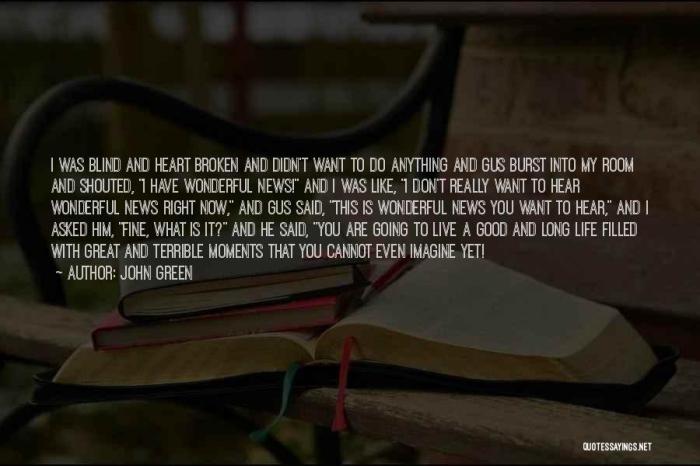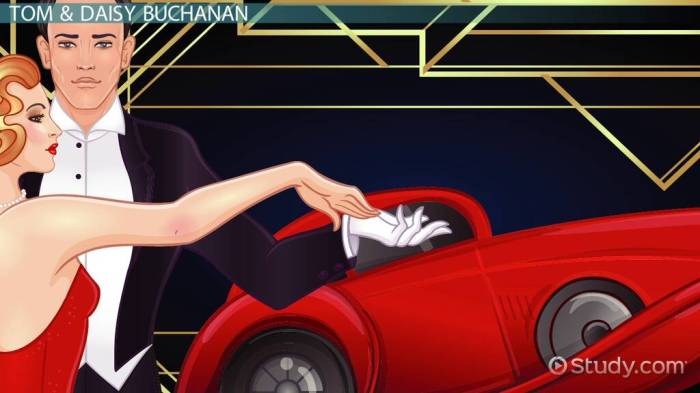Greed in the great gatsby quotes – Greed in The Great Gatsby: Literary Insights and Historical Context delves into the profound exploration of greed within F. Scott Fitzgerald’s masterpiece, providing a comprehensive analysis of its literary manifestations, thematic significance, and historical backdrop.
This meticulously crafted work offers a nuanced understanding of how greed shapes the characters, distorts the American Dream, and reflects the rampant materialism of the Roaring Twenties.
Literary Examples of Greed in The Great Gatsby
In F. Scott Fitzgerald’s masterpiece, The Great Gatsby, greed is a pervasive theme that drives many of the characters’ actions and ultimately leads to their downfall.
Here are a few notable examples of greed in the novel:
Tom Buchanan
- “He wanted to go West and work up a business and make money.”(Chapter 1)
- “He’s a rotten crowd… I wouldn’t trust him with a dollar of my money.”(Chapter 3)
Tom’s greed is evident in his desire for wealth and his distrust of others. He sees money as a means to power and control, and he is willing to do whatever it takes to acquire more of it.
Daisy Buchanan, Greed in the great gatsby quotes
- “I’m glad it’s a girl. And I hope she’ll be a fool—that’s the best thing a girl can be in this world, a beautiful little fool.”(Chapter 7)
- “She had a voice full of money.”(Chapter 7)
Daisy’s greed is more subtle than Tom’s, but it is no less destructive. She is obsessed with material possessions and social status, and she is willing to sacrifice her own happiness and the happiness of others to maintain her luxurious lifestyle.
Jay Gatsby
- “Can’t repeat the past? Why of course you can!”(Chapter 6)
- “He had come a long way to this blue lawn, and his dream must have seemed so close that he could hardly fail to grasp it.”(Chapter 6)
Gatsby’s greed is rooted in his desire to recreate the past. He believes that if he can amass enough wealth and power, he can win back Daisy’s love and erase the mistakes of his youth. However, his greed ultimately leads to his downfall, as he becomes so consumed by his dream that he loses sight of reality.
The Role of Greed in Gatsby’s Character

Jay Gatsby’s pursuit of wealth and status is driven by an insatiable greed that ultimately leads to his downfall. His desire for material possessions and social acceptance stems from a deep-seated insecurity and a belief that these things will bring him happiness and fulfillment.
Gatsby’s Greed for Wealth
Gatsby’s relentless pursuit of wealth is evident throughout the novel. He amasses a vast fortune through questionable means, including bootlegging and gambling. His lavish parties and opulent mansion are symbols of his wealth, which he uses to attract attention and gain acceptance into high society.
However, Gatsby’s greed for wealth ultimately becomes his undoing. His illegal activities put him in danger, and his obsession with money blinds him to the true nature of his relationships. He believes that his wealth will make him invincible, but in reality, it isolates him from those who truly care about him.
Gatsby’s Greed for Status
In addition to his greed for wealth, Gatsby also harbors a deep desire for social status. He longs to be accepted by the upper class, whom he believes are superior to him. He spends lavishly on parties and throws himself into the social scene in an attempt to gain their approval.
However, Gatsby’s greed for status ultimately leads to his downfall. His attempts to impress the upper class are met with condescension and rejection. He is never truly accepted into their world, and his pursuit of status leaves him feeling empty and unfulfilled.
The Impact of Greed on the American Dream

The Great Gatsby is a novel that explores the American Dream and the corrupting influence of greed. The characters in the novel all embody different aspects of the American Dream, but they are ultimately corrupted by their own greed. Gatsby, for example, is a self-made millionaire who has achieved the American Dream of wealth and success.
However, he is also driven by a desire for Daisy Buchanan, a woman who represents the unattainable ideal of American beauty and wealth. Gatsby’s greed for Daisy ultimately leads to his downfall.
The American Dream
The American Dream is the idea that anyone can achieve success and prosperity through hard work and determination. It is a powerful ideal that has inspired generations of Americans to strive for a better life. However, the American Dream can also be corrupted by greed.
When people become too focused on achieving wealth and success, they can lose sight of the true meaning of happiness. They may also become willing to do whatever it takes to achieve their goals, even if it means hurting others.
The Corrupting Influence of Greed
Greed is a destructive force that can corrupt even the best of people. It can lead to selfishness, dishonesty, and violence. In The Great Gatsby, greed corrupts all of the main characters. Gatsby is driven by his greed for Daisy, Tom Buchanan is driven by his greed for wealth and power, and Daisy is driven by her greed for a life of luxury.
These characters’ greed ultimately leads to their downfall.
The Novel’s Critique of American Materialism and Excess
The Great Gatsby is a critique of American materialism and excess. The novel shows how the pursuit of wealth and status can lead to corruption and unhappiness. Fitzgerald also criticizes the American tendency to judge people based on their wealth and social status.
The novel’s characters are all flawed, but they are also victims of a society that values wealth and status above all else.
Historical Context of Greed in the Roaring Twenties

The 1920s, also known as the “Roaring Twenties,” was a period of significant economic and social change in the United States. The decade was characterized by rapid economic growth, rising consumerism, and a widespread sense of optimism. However, this era was also marked by rampant greed and materialism, which is vividly depicted in F.
Scott Fitzgerald’s novel “The Great Gatsby.”
Economic Conditions
The economic conditions of the 1920s were highly conducive to the growth of greed. The decade saw a significant increase in industrial production and economic output, leading to rising profits and wealth accumulation. The stock market also boomed during this period, creating the illusion of easy wealth and quick profits.
Many people became caught up in the frenzy of speculation and investment, hoping to make a fortune quickly.
Social Conditions
The social conditions of the 1920s also contributed to the rise of greed. The decade was marked by a breakdown of traditional values and a growing emphasis on individualism and self-interest. People began to place a greater importance on material possessions and status symbols, and there was a widespread belief that wealth and success were the ultimate measures of worth.
The Great Gatsby and the Roaring Twenties
Fitzgerald’s novel “The Great Gatsby” is a powerful indictment of the greed and materialism of the Roaring Twenties. The novel’s protagonist, Jay Gatsby, is a self-made millionaire who has achieved wealth through questionable means. Gatsby’s relentless pursuit of wealth and his belief that money can buy happiness are ultimately his downfall.The
novel also explores the corrosive effects of greed on society as a whole. The characters in “The Great Gatsby” are constantly striving for more, and their insatiable desires lead to moral decay and disillusionment. The novel’s tragic ending serves as a warning about the dangers of unchecked greed.
Symbolism of Greed in The Great Gatsby
F. Scott Fitzgerald’s The Great Gatsbyis a novel that explores the corrosive effects of greed. The novel is set in the Roaring Twenties, a time of great economic prosperity, but also a time of rampant materialism and excess. This greed is symbolized through various objects and motifs throughout the novel.
The Green Light
The green light at the end of Daisy’s dock is one of the most iconic symbols in the novel. It represents Gatsby’s unattainable dream of winning back Daisy, a woman he lost to Tom Buchanan. The green light is a symbol of hope and longing, but it is also a symbol of Gatsby’s greed.
He is so consumed by his desire to possess Daisy that he is willing to do anything to get her, even if it means breaking the law or hurting others.
The Valley of Ashes
The Valley of Ashes is a desolate wasteland that separates West Egg from New York City. It is a symbol of the moral and economic decay that is rampant in the Roaring Twenties. The Valley of Ashes is home to the poor and working class, who are exploited by the wealthy elite.
The valley is a reminder that the American Dream is not available to everyone, and that greed can lead to great suffering.
The Eyes of Dr. T.J. Eckleburg
The eyes of Dr. T.J. Eckleburg are a pair of giant billboard advertisements that overlook the Valley of Ashes. They are a symbol of the all-seeing eye of God, and they serve as a reminder that even the most hidden sins will be revealed.
The eyes of Dr. T.J. Eckleburg are a warning to those who are tempted by greed, that they will eventually be held accountable for their actions.
Answers to Common Questions: Greed In The Great Gatsby Quotes
How does greed contribute to Gatsby’s downfall?
Gatsby’s relentless pursuit of wealth and status, driven by his desire to recapture the past, ultimately leads to his tragic demise. His greed blinds him to the true nature of his relationships and the emptiness of his material possessions.
What is the significance of the green light at the end of Daisy’s dock?
The green light symbolizes Gatsby’s unattainable dream of Daisy and the elusive nature of the American Dream itself. It represents his longing for a past that can never be fully recovered and the futility of chasing material wealth as a substitute for genuine happiness.